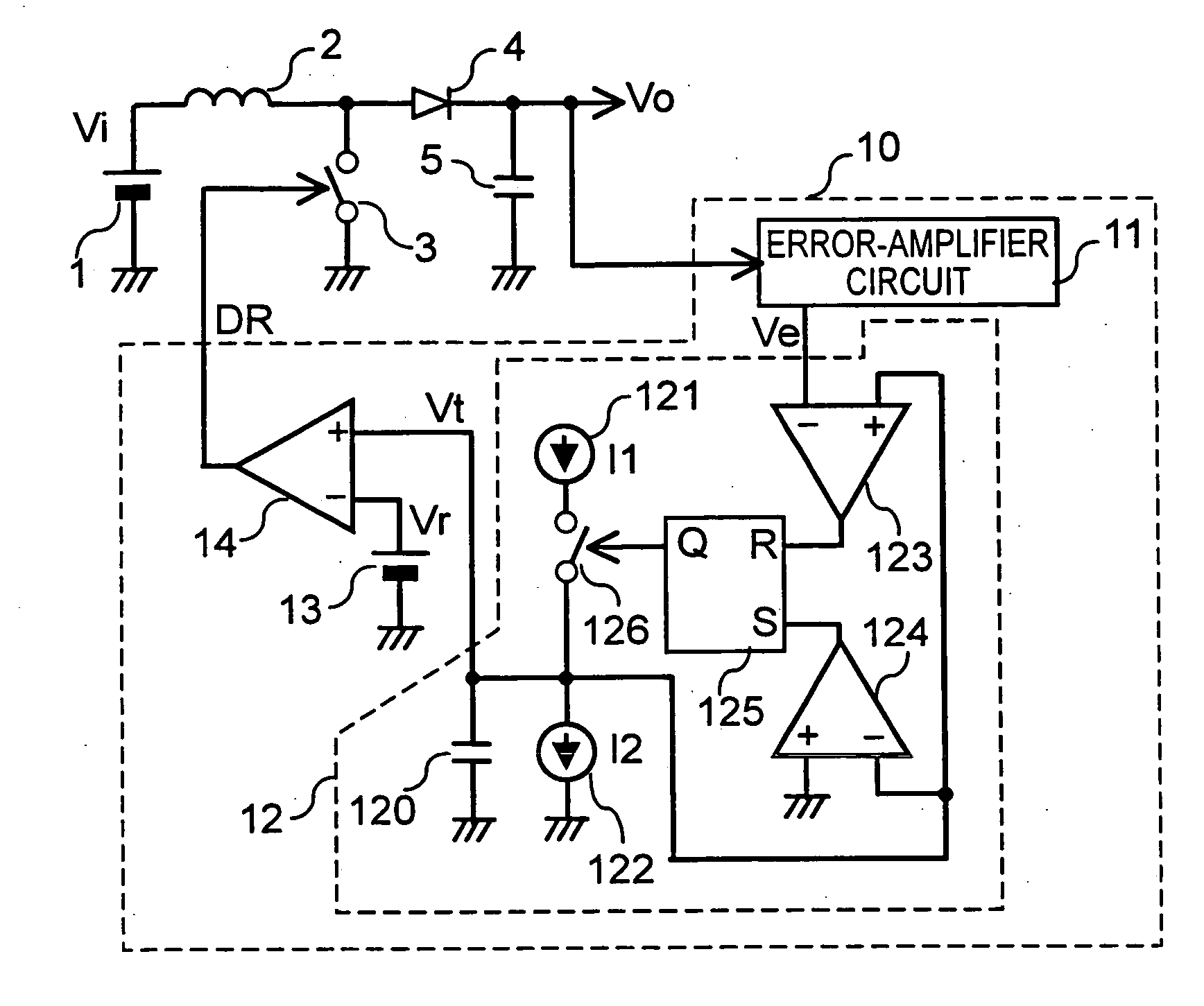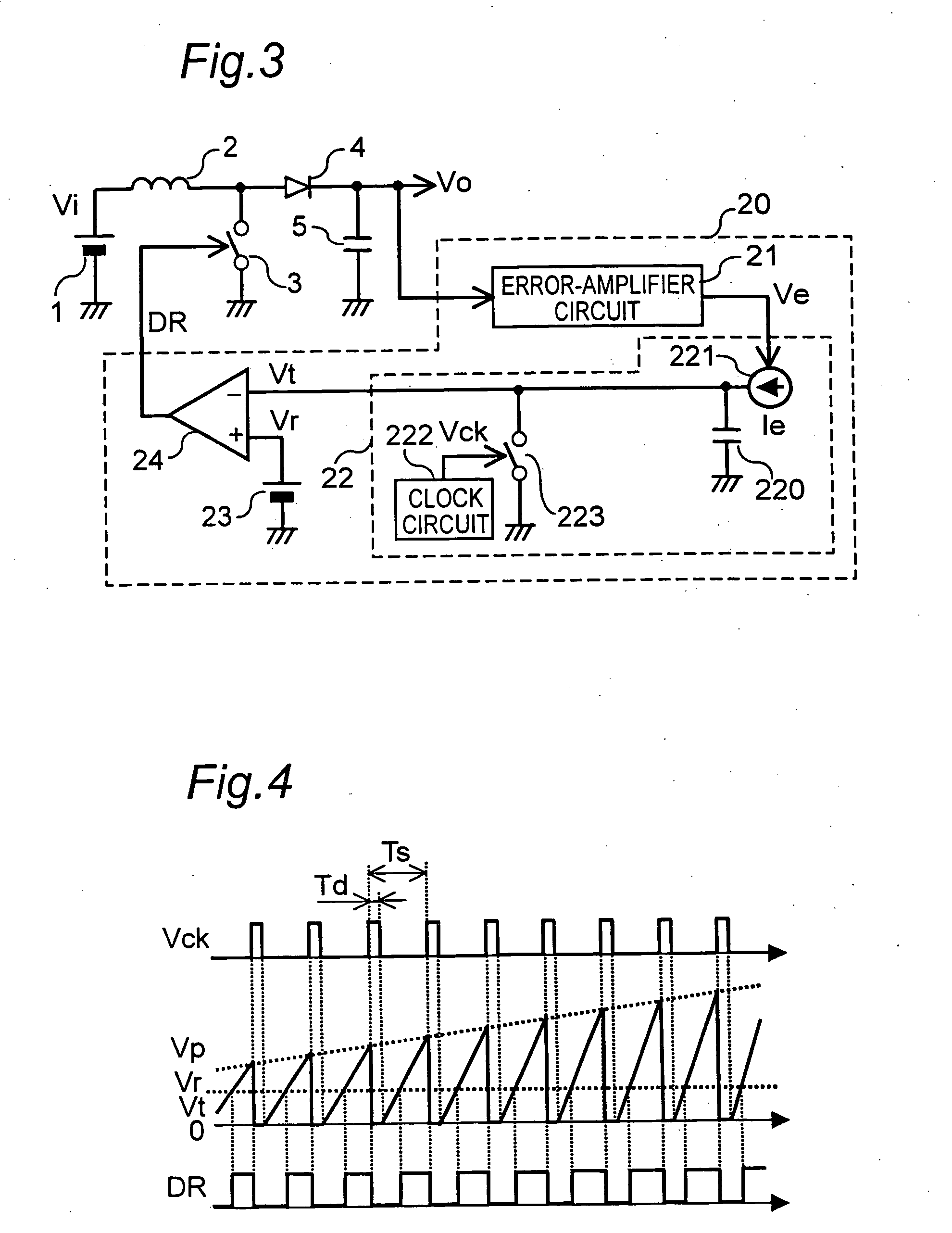DC-DC converter and control circuit thereof
a technology of dc-dc converter and control circuit, which is applied in the direction of dc-dc converter, power conversion system, instruments, etc., can solve the problems of easy instability of output dc voltage, and achieve the effect of facilitating the design of stabilizing the feedback system and stable operation
- Summary
- Abstract
- Description
- Claims
- Application Information
AI Technical Summary
Benefits of technology
Problems solved by technology
Method used
Image
Examples
first embodiment
[0042]FIG. 1 is a circuit diagram showing the configuration of a DC-DC converter and its control circuit according to the present invention.
[0043] As shown in FIG. 1, an input DC power supply 1, such as a battery, is connected to one terminal of an inductor 2. To the other terminal of the inductor 2, one terminal of a switching device 3 formed of a MOSFET and one terminal of a rectifying means 4 formed of a diode are connected. The other terminal of the switching device 3 is grounded. One terminal of a smoothing means 5 formed of a capacitor is grounded, and the other terminal thereof is connected to the other terminal of the rectifying means 4. Furthermore, the other terminal of the rectifying means 4 serves as an output terminal and is connected to a control circuit 10. The inductor 2 and the switching device 3 are connected in series, and this series circuit is connected in parallel with the input DC power supply 1. The rectifying means 4 is connected to the connection point of t...
embodiment 1
[0050] In the steady state of the control circuit of the DC-DC converter according to Embodiment 1 of the present invention, wherein the output DC voltage Vo is stabilized, the relationships represented by Expressions (4) and (5) described below are established.
Vo=Vi / (1−D)=Vi·Ve / Vr (4)
∂Vo / ∂Ve=Vi / Vr (5)
[0051] As described above, the relationship between the error signal Ve and the output DC voltage Vo is linear, and the rate of change (∂Vo / ∂Ve) of the output DC voltage Vo due to the error signal Ve does not depend on the level of the error signal Ve. For this reason, the design of stabilizing the feedback system is facilitated.
[0052] Furthermore, because the duty ratio D is determined by the error signal Ve and the reference signal Vr as indicated in Expression (3), the maximum duty ratio Dmax can be set using the maximum value of the error signal Ve and the reference signal Vr.
[0053]>
[0054]FIG. 3 is a circuit diagram showing the configuration of a DC-DC converter and its contr...
embodiment 2
[0062] In the steady state of the control circuit of the DC-DC converter according to Embodiment 2 according to the present invention, wherein the output DC voltage Vo is stabilized, the relationships represented by Expressions (9) and (10) described below are established. Vo=Vi / (1-D)(9) =Vi·Ve·Ts / (Vr·C 2·Re) ∂Vo / ∂Ve=Vi·Ts / (Vr·C 2·Re)(10)
PUM
 Login to View More
Login to View More Abstract
Description
Claims
Application Information
 Login to View More
Login to View More - R&D
- Intellectual Property
- Life Sciences
- Materials
- Tech Scout
- Unparalleled Data Quality
- Higher Quality Content
- 60% Fewer Hallucinations
Browse by: Latest US Patents, China's latest patents, Technical Efficacy Thesaurus, Application Domain, Technology Topic, Popular Technical Reports.
© 2025 PatSnap. All rights reserved.Legal|Privacy policy|Modern Slavery Act Transparency Statement|Sitemap|About US| Contact US: help@patsnap.com



